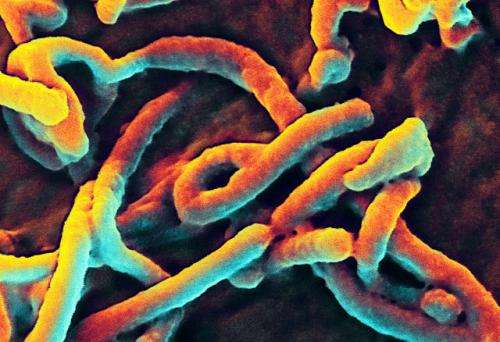Research reveals how Ebola evades immune defenses

Mount Sinai researchers have uncovered the complex cellular mechanisms of Ebola virus, which could help explain its severe toll on humans and identify potential pathways to treatment and prevention. In a study published in mBio, the team reported how a protein of the Ebola virus, VP24, interacts with the double-layered membrane of the cell nucleus (known as the nuclear envelope), leading to significant damage to cells along with virus replication and the propagation of disease.
"The Ebola virus is extremely skilled at dodging the body's immune defenses, and in our study we characterize an important way in which that evasion occurs through disruption of the nuclear envelope, mediated by the VP24 protein," says co-senior author Adolfo García-Sastre, Ph.D., Professor of Microbiology, and Director of the Global Health and Emerging Pathogens Institute of the Icahn School of Medicine at Mount Sinai. "That disruption is quite dramatic and replicates rare, genetic diseases known as laminopathies, which can result in severe muscular, cardiovascular, and neuronal complications."
After first appearing in 1976 in Africa, the Ebola virus has triggered a number of outbreaks on that continent, the most serious from 2014 to 2016 in West Africa, with a 50 percent mortality rate among its victims. The virus, which causes severe hemorrhagic fever, is transmitted to people from wild animals and spreads through human-to-human transmission.
In their laboratory work—much of it conducted with research partners from CIMUS at the Universidad de Santiago de Compostela in Spain, and the Bernhard Nocht Institute for Tropical Medicine in Hamburg, Germany—investigators identified the cellular membrane components that interact with VP24 to prompt nuclear membrane disruption. These components are emerin and the inner membrane constituents lamin A/C and lamin B. Specifically, the VP24 protein decreases interaction of lamin A/C and emerin, compromising the integrity of the nuclear membrane, which, in turn, results in leakage of DNA and the loss of function by the body's disease-fighting cells.
The researchers further showed that VP24 disrupts signaling pathways that are meant to activate the immune system's defenses against viral invaders like Ebola. The biological consequence of this is even greater interference with the normal physiology of cells, including antiviral immunity.
"We believe our discovery of the novel activities of the Ebola VP24 protein and the severe damage it causes to infected cells will help to promote further research into effective ways to treat and prevent the spread of deadly viruses, perhaps through a new inhibitor," says Dr. García-Sastre, who has spent the past 25 years focused on the molecular biology of rare and common viruses. "Indeed, that research will hopefully identify even more precisely the molecular mechanisms by which viruses like Ebola invade the body and find ways to cleverly avoid its immune defenses."
More information: Santiago Vidal et al, Expression of the Ebola Virus VP24 Protein Compromises the Integrity of the Nuclear Envelope and Induces a Laminopathy-Like Cellular Phenotype, mBio (2021). DOI: 10.1128/mBio.00972-21
















